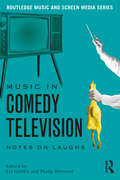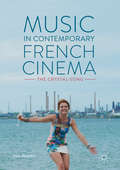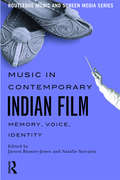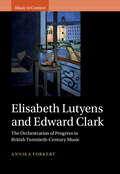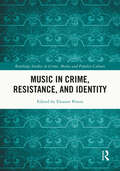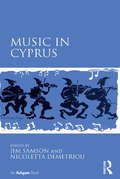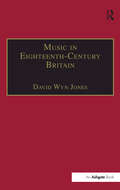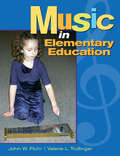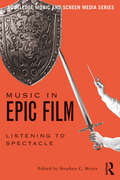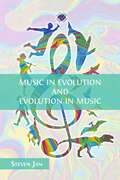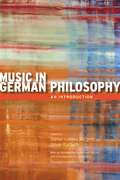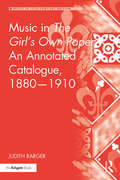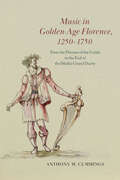- Table View
- List View
Music in Comedy Television: Notes on Laughs
by Liz Giuffre Philip HaywardThe study of television and music has expanded greatly in recent years, yet to date no book has focused on the genre of comedy television as it relates to music. Music in Comedy Television: Notes on Laughs fills that gap, breaking new critical ground. With contributions from an array of established and emerging scholars representing a range of disciplines, the twelve essays included cover a wide variety of topics and television shows, spanning nearly fifty years across network, cable, and online structures and capturing the latest research in this growing area of study. From Sesame Street to Saturday Night Live, from Monty Python to Flight of the Conchords, this book offers the perfect introduction for students and scholars in music and media studies seeking to understand the role of music in comedy onscreen and how it relates to the wider culture.
Music in Comedy Television: Notes on Laughs
by Liz Giuffre Philip HaywardThe study of television and music has expanded greatly in recent years, yet to date no book has focused on the genre of comedy television as it relates to music. Music in Comedy Television: Notes on Laughs fills that gap, breaking new critical ground. With contributions from an array of established and emerging scholars representing a range of disciplines, the twelve essays included cover a wide variety of topics and television shows, spanning nearly fifty years across network, cable, and online structures and capturing the latest research in this growing area of study. From Sesame Street to Saturday Night Live, from Monty Python to Flight of the Conchords, this book offers the perfect introduction for students and scholars in music and media studies seeking to understand the role of music in comedy onscreen and how it relates to the wider culture.
Music in Contemporary French Cinema: The Crystal-Song
by Phil PowrieThis book explores composed scores and pre-existing music in French cinema from 1985 to 2015 so as to identify critical musical moments. It shows how heritage films construct space through music, generating what Powrie calls “third space music,” while also working to contain the strong women characters found in French heritage films through the use of leitmotifs and musical cues. He analyses fiction films in which the protagonists perform at the piano, showing how musical performance supports the performance of gender. Building on aspects of musical performance, and in particular the use of songs performed in films, Powrie uses a database of 300 films since 2010 to theorize the intervention of music at critical moments as a “crystal-song”. Applying Roland Barthes’s concept of the “punctum” and Gille Deleuze’s concept of the “crystal-image,” Powrie establishes the importance of the crystal-song, which reconfigures time as a crystallization of past, present and future.
Music in Contemporary French Cinema: The Crystal-Song
by Phil PowrieThis book explores composed scores and pre-existing music in French cinema from 1985 to 2015 so as to identify critical musical moments. It shows how heritage films construct space through music, generating what Powrie calls “third space music,” while also working to contain the strong women characters found in French heritage films through the use of leitmotifs and musical cues. He analyses fiction films in which the protagonists perform at the piano, showing how musical performance supports the performance of gender. Building on aspects of musical performance, and in particular the use of songs performed in films, Powrie uses a database of 300 films since 2010 to theorize the intervention of music at critical moments as a “crystal-song”. Applying Roland Barthes’s concept of the “punctum” and Gille Deleuze’s concept of the “crystal-image,” Powrie establishes the importance of the crystal-song, which reconfigures time as a crystallization of past, present and future.
Music in Contemporary Indian Film: Memory, Voice, Identity
by Jayson Beaster-Jones Natalie SarrazinMusic in Contemporary Indian Film: Memory, Voice, Identity provides a rich and detailed look into the unique dimensions of music in Indian film. Music is at the center of Indian cinema, and India’s film music industry has a far-reaching impact on popular, folk, and classical music across the subcontinent and the South Asian diaspora. In twelve essays written by an international array of scholars, this book explores the social, cultural, and musical aspects of the industry, including both the traditional center of "Bollywood" and regional film-making. Concentrating on films and songs created in contemporary, post-liberalization India, this book will appeal to classes in film studies, media studies, and world music, as well as all fans of Indian films.
Music in Contemporary Indian Film: Memory, Voice, Identity (Routledge Music And Screen Media Ser.)
by Jayson Beaster-Jones Natalie SarrazinMusic in Contemporary Indian Film: Memory, Voice, Identity provides a rich and detailed look into the unique dimensions of music in Indian film. Music is at the center of Indian cinema, and India’s film music industry has a far-reaching impact on popular, folk, and classical music across the subcontinent and the South Asian diaspora. In twelve essays written by an international array of scholars, this book explores the social, cultural, and musical aspects of the industry, including both the traditional center of "Bollywood" and regional film-making. Concentrating on films and songs created in contemporary, post-liberalization India, this book will appeal to classes in film studies, media studies, and world music, as well as all fans of Indian films.
Music in Context: The Orchestration Of Progress In British Twentieth-century Music (Music In Context Ser.)
by Annika ForkertMusic in Crime, Resistance, and Identity (Routledge Studies in Crime, Culture and Media)
by Eleanor PetersThis book considers the intersection of music, politics and identity, focusing on music (genres) across the world as a form of political expression and protest, positive identity formations, and also how the criminalisation, censuring, policing and prosecution of musicians and fans can occur. All-encompassing in this book is analyses of the unique contribution of music to various aspects of human activity through an international, multi-disciplinary approach. The book will serve as a starting point for scholars in those areas where there has been an uncertain approach to this subject, while those from disciplines with a more established canon of music analysis will be informed about what each perspective can offer. The approach is international and multi-disciplinary, with the contributing authors focusing on a range of countries and the differing social and cultural impact of music for both musicians and fans. Academic disciplines can provide some explanations, but the importance of the contribution of practitioners is vital for a fully rounded understanding of the impact of music. Therefore, this book takes the reader on a journey, beginning with theoretical and philosophical perspectives on music and society, proceeding to an analysis of laws and policies, and concluding with the use of music by educational practitioners and the people with whom they work. This book will appeal to students and scholars in subjects such as sociology, criminology, cultural studies, and across the wider social sciences. It will also be of interest to practitioners in youth justice or those with other involvement in the criminal justice system.
Music in Crime, Resistance, and Identity (Routledge Studies in Crime, Culture and Media)
by Eleanor PetersThis book considers the intersection of music, politics and identity, focusing on music (genres) across the world as a form of political expression and protest, positive identity formations, and also how the criminalisation, censuring, policing and prosecution of musicians and fans can occur. All-encompassing in this book is analyses of the unique contribution of music to various aspects of human activity through an international, multi-disciplinary approach. The book will serve as a starting point for scholars in those areas where there has been an uncertain approach to this subject, while those from disciplines with a more established canon of music analysis will be informed about what each perspective can offer. The approach is international and multi-disciplinary, with the contributing authors focusing on a range of countries and the differing social and cultural impact of music for both musicians and fans. Academic disciplines can provide some explanations, but the importance of the contribution of practitioners is vital for a fully rounded understanding of the impact of music. Therefore, this book takes the reader on a journey, beginning with theoretical and philosophical perspectives on music and society, proceeding to an analysis of laws and policies, and concluding with the use of music by educational practitioners and the people with whom they work. This book will appeal to students and scholars in subjects such as sociology, criminology, cultural studies, and across the wider social sciences. It will also be of interest to practitioners in youth justice or those with other involvement in the criminal justice system.
Music in Cyprus
by Jim Samson Nicoletta DemetriouMusic in Cyprus draws its authors from both sides of the divided island to give a rounded picture of musical culture from the beginning of the British colonial period (1878-1960) until today. The book crosses conventional scholarly divides between musicology and ethnomusicology in order to achieve a panorama of music, culture and politics. Shared practices of traditional music and dance are outlined, and the appropriation of those practices by both communities in the aftermath of the de facto division of the island is examined. Art music (European and Ottoman) is also discussed, both in terms of the structures of musical life and the creative praxes of composers, and there is an account of the early stages of a popular music industry. The authors consider such questions as: What is the role of different musics in defining national, regional, social and cultural identities in Cyprus? How do Cypriot alterities illuminate European projects of modernity? And what has been the impact of westernization and modernization (and, conversely, of orientalization) on music in Cyprus? The book will be of interest to students and academics working not only in both historical musicology and ethnomusicology, but also in the history and anthropology of Cyprus and of the entire Greek-Anatolian region.
Music in Cyprus
by Jim Samson Nicoletta DemetriouMusic in Cyprus draws its authors from both sides of the divided island to give a rounded picture of musical culture from the beginning of the British colonial period (1878-1960) until today. The book crosses conventional scholarly divides between musicology and ethnomusicology in order to achieve a panorama of music, culture and politics. Shared practices of traditional music and dance are outlined, and the appropriation of those practices by both communities in the aftermath of the de facto division of the island is examined. Art music (European and Ottoman) is also discussed, both in terms of the structures of musical life and the creative praxes of composers, and there is an account of the early stages of a popular music industry. The authors consider such questions as: What is the role of different musics in defining national, regional, social and cultural identities in Cyprus? How do Cypriot alterities illuminate European projects of modernity? And what has been the impact of westernization and modernization (and, conversely, of orientalization) on music in Cyprus? The book will be of interest to students and academics working not only in both historical musicology and ethnomusicology, but also in the history and anthropology of Cyprus and of the entire Greek-Anatolian region.
Music in Eighteenth-Century Britain
by DavidWyn JonesThis collection of essays by some of the leading scholars in the field looks at various aspects of musical life in eighteenth-century Britain. The significant roles played by institutions such as the Freemasons and foreign embassy chapels in promoting music making and introducing foreign styles to English music are examined, as well as the influence exerted by individuals, both foreign and British. The book covers the spectrum of British music, both sacred and secular, and both cosmopolitan and provincial. In doing so it helps to redress the picture of eighteenth-century British music which has previously portrayed Handel and London as its primary constituents.
Music in Eighteenth-Century Britain
by DavidWyn JonesThis collection of essays by some of the leading scholars in the field looks at various aspects of musical life in eighteenth-century Britain. The significant roles played by institutions such as the Freemasons and foreign embassy chapels in promoting music making and introducing foreign styles to English music are examined, as well as the influence exerted by individuals, both foreign and British. The book covers the spectrum of British music, both sacred and secular, and both cosmopolitan and provincial. In doing so it helps to redress the picture of eighteenth-century British music which has previously portrayed Handel and London as its primary constituents.
Music in Elementary Education
by John Flohr Valerie TrollingerBased on the National Standards, this text is divided into three parts. Part one, Foundations, covers the rationale for a Music Education program in the elementary years; meaning and musical experience; and elements and kinds of music. Part two– Music Elements, Curriculum and Avenues to Music Learning–covers curriculum development; music for special needs students; avenues to music learning and historic and contemporary approaches. Part three–Musical Experiences– is grouped by avenues of music learning and grades. Thanks to years of thorough research, Music in Elementary Education promises is a standard text in the field.
Music in Elementary Education
by John Flohr Valerie TrollingerBased on the National Standards, this text is divided into three parts. Part one, Foundations, covers the rationale for a Music Education program in the elementary years; meaning and musical experience; and elements and kinds of music. Part two– Music Elements, Curriculum and Avenues to Music Learning–covers curriculum development; music for special needs students; avenues to music learning and historic and contemporary approaches. Part three–Musical Experiences– is grouped by avenues of music learning and grades. Thanks to years of thorough research, Music in Elementary Education promises is a standard text in the field.
Music in Epic Film: Listening to Spectacle
by Stephen C. MeyerAs both a distinct genre and a particular mode of filmmaking, the idea of the epic has been central to the history of cinema. Including contributions from both established and emerging film music scholars, the ten essays in Music in Epic Film: Listening to Spectacle provide a cross-section of contemporary scholarship on the subject. They explore diverse topics, including the function of music in epic narratives, the socio-political implications of cinematic music, and the use of pre-existing music in epic films. Intended for students and scholars in film music, film appreciation, and media studies, the wide range of topics and the diversity of the films that the authors discuss make Music in Epic Film: Listening to Spectacle an ideal introduction to the field of music in epic film.
Music in Epic Film: Listening to Spectacle
by Stephen C. MeyerAs both a distinct genre and a particular mode of filmmaking, the idea of the epic has been central to the history of cinema. Including contributions from both established and emerging film music scholars, the ten essays in Music in Epic Film: Listening to Spectacle provide a cross-section of contemporary scholarship on the subject. They explore diverse topics, including the function of music in epic narratives, the socio-political implications of cinematic music, and the use of pre-existing music in epic films. Intended for students and scholars in film music, film appreciation, and media studies, the wide range of topics and the diversity of the films that the authors discuss make Music in Epic Film: Listening to Spectacle an ideal introduction to the field of music in epic film.
Music in Evolution and Evolution in Music: (pdf)
by Steven JanMusic in Evolution and Evolution in Music by Steven Jan is a comprehensive account of the relationships between evolutionary theory and music. Examining the ‘evolutionary algorithm’ that drives biological and musical-cultural evolution, the book provides a distinctive commentary on how musicality and music can shed light on our understanding of Darwin’s famous theory, and vice-versa. Comprised of seven chapters, with several musical examples, figures and definitions of terms, this original and accessible book is a valuable resource for anyone interested in the relationships between music and evolutionary thought. Jan guides the reader through key evolutionary ideas and the development of human musicality, before exploring cultural evolution, evolutionary ideas in musical scholarship, animal vocalisations, music generated through technology, and the nature of consciousness as an evolutionary phenomenon. A unique examination of how evolutionary thought intersects with music, Music in Evolution and Evolution in Music is essential to our understanding of how and why music arose in our species and why it is such a significant presence in our lives.
Music in German Philosophy: An Introduction
by Stefan Lorenz Sorgner Oliver Fürbeth Susan H. GillespieThough many well-known German philosophers have devoted considerable attention to music and its aesthetics, surprisingly few of their writings on the subject have been translated into English. Stefan Lorenz Sorgner, a philosopher, and Oliver Fürbeth, a musicologist, here fill this important gap for musical scholars and students alike with this compelling guide to the musical discourse of ten of the most important German philosophers, from Kant to Adorno. Music in German Philosophy includes contributions from a renowned group of ten scholars, including some of today’s most prominent German thinkers, all of whom are specialists in the writers they treat. Each chapter consists of a short biographical sketch of the philosopher concerned, a summary of his writings on aesthetics, and finally a detailed exploration of his thoughts on music. The book is prefaced by the editors’ original introduction, presenting music philosophy in Germany before and after Kant, as well as a new introduction and foreword to this English-language addition, which places contemplations on music by these German philosophers within a broader intellectual climate.
Music in German Philosophy: An Introduction
by Stefan Lorenz Sorgner Oliver Fürbeth Susan H. GillespieThough many well-known German philosophers have devoted considerable attention to music and its aesthetics, surprisingly few of their writings on the subject have been translated into English. Stefan Lorenz Sorgner, a philosopher, and Oliver Fürbeth, a musicologist, here fill this important gap for musical scholars and students alike with this compelling guide to the musical discourse of ten of the most important German philosophers, from Kant to Adorno. Music in German Philosophy includes contributions from a renowned group of ten scholars, including some of today’s most prominent German thinkers, all of whom are specialists in the writers they treat. Each chapter consists of a short biographical sketch of the philosopher concerned, a summary of his writings on aesthetics, and finally a detailed exploration of his thoughts on music. The book is prefaced by the editors’ original introduction, presenting music philosophy in Germany before and after Kant, as well as a new introduction and foreword to this English-language addition, which places contemplations on music by these German philosophers within a broader intellectual climate.
Music in German Philosophy: An Introduction
by Stefan Lorenz Sorgner Oliver Fürbeth Susan H. Gillespie H. James Birx Michael SpitzerThough many well-known German philosophers have devoted considerable attention to music and its aesthetics, surprisingly few of their writings on the subject have been translated into English. Stefan Lorenz Sorgner, a philosopher, and Oliver Fürbeth, a musicologist, here fill this important gap for musical scholars and students alike with this compelling guide to the musical discourse of ten of the most important German philosophers, from Kant to Adorno. Music in German Philosophy includes contributions from a renowned group of ten scholars, including some of today’s most prominent German thinkers, all of whom are specialists in the writers they treat. Each chapter consists of a short biographical sketch of the philosopher concerned, a summary of his writings on aesthetics, and finally a detailed exploration of his thoughts on music. The book is prefaced by the editors’ original introduction, presenting music philosophy in Germany before and after Kant, as well as a new introduction and foreword to this English-language addition, which places contemplations on music by these German philosophers within a broader intellectual climate.
Music in The Girl's Own Paper: An Annotated Catalogue, 1880-1910 (Music in Nineteenth-Century Britain)
by Judith BargerNineteenth-century British periodicals for girls and women offer a wealth of material to understand how girls and women fit into their social and cultural worlds, of which music making was an important part. The Girl's Own Paper, first published in 1880, stands out because of its rich musical content. Keeping practical usefulness as a research tool and as a guide to further reading in mind, Judith Barger has catalogued the musical content found in the weekly and later monthly issues during the magazine's first thirty years, in music scores, instalments of serialized fiction about musicians, music-related nonfiction, poetry with a musical title or theme, illustrations depicting music making and replies to musical correspondents. The book's introductory chapter reveals how content in The Girl's Own Paper changed over time to reflect a shift in women's music making from a female accomplishment to an increasingly professional role within the discipline, using 'the piano girl' as a case study. A comparison with musical content found in The Boy's Own Paper over the same time span offers additional insight into musical content chosen for the girls' magazine. A user's guide precedes the chronological annotated catalogue; the indexes that follow reveal the magazine's diversity of approach to the subject of music.
Music in The Girl's Own Paper: An Annotated Catalogue, 1880-1910 (Music in Nineteenth-Century Britain)
by Judith BargerNineteenth-century British periodicals for girls and women offer a wealth of material to understand how girls and women fit into their social and cultural worlds, of which music making was an important part. The Girl's Own Paper, first published in 1880, stands out because of its rich musical content. Keeping practical usefulness as a research tool and as a guide to further reading in mind, Judith Barger has catalogued the musical content found in the weekly and later monthly issues during the magazine's first thirty years, in music scores, instalments of serialized fiction about musicians, music-related nonfiction, poetry with a musical title or theme, illustrations depicting music making and replies to musical correspondents. The book's introductory chapter reveals how content in The Girl's Own Paper changed over time to reflect a shift in women's music making from a female accomplishment to an increasingly professional role within the discipline, using 'the piano girl' as a case study. A comparison with musical content found in The Boy's Own Paper over the same time span offers additional insight into musical content chosen for the girls' magazine. A user's guide precedes the chronological annotated catalogue; the indexes that follow reveal the magazine's diversity of approach to the subject of music.
Music in Golden-Age Florence, 1250–1750: From the Priorate of the Guilds to the End of the Medici Grand Duchy
by Anthony M. CummingsA comprehensive account of music in Florence from the late Middle Ages until the end of the Medici dynasty in the mid-eighteenth century. Florence is justly celebrated as one of the world’s most important cities. It enjoys mythic status and occupies an enviable place in the historical imagination. But its musico-historical importance is not as well understood as it should be. If Florence was the city of Dante, Michelangelo, and Galileo, it was also the birthplace of the madrigal, opera, and the piano. Music in Golden-Age Florence, 1250–1750 recounts Florence’s principal contributions to music and the history of how music was heard and cultivated in the city, from civic and religious institutions to private patronage and the academies. This book is an invaluable complement to studies of the art, literature, and political thought of the late-medieval and early-modern eras and the quasi-legendary figures in the Florentine cultural pantheon.
Music in Golden-Age Florence, 1250–1750: From the Priorate of the Guilds to the End of the Medici Grand Duchy
by Anthony M. CummingsA comprehensive account of music in Florence from the late Middle Ages until the end of the Medici dynasty in the mid-eighteenth century. Florence is justly celebrated as one of the world’s most important cities. It enjoys mythic status and occupies an enviable place in the historical imagination. But its musico-historical importance is not as well understood as it should be. If Florence was the city of Dante, Michelangelo, and Galileo, it was also the birthplace of the madrigal, opera, and the piano. Music in Golden-Age Florence, 1250–1750 recounts Florence’s principal contributions to music and the history of how music was heard and cultivated in the city, from civic and religious institutions to private patronage and the academies. This book is an invaluable complement to studies of the art, literature, and political thought of the late-medieval and early-modern eras and the quasi-legendary figures in the Florentine cultural pantheon.
